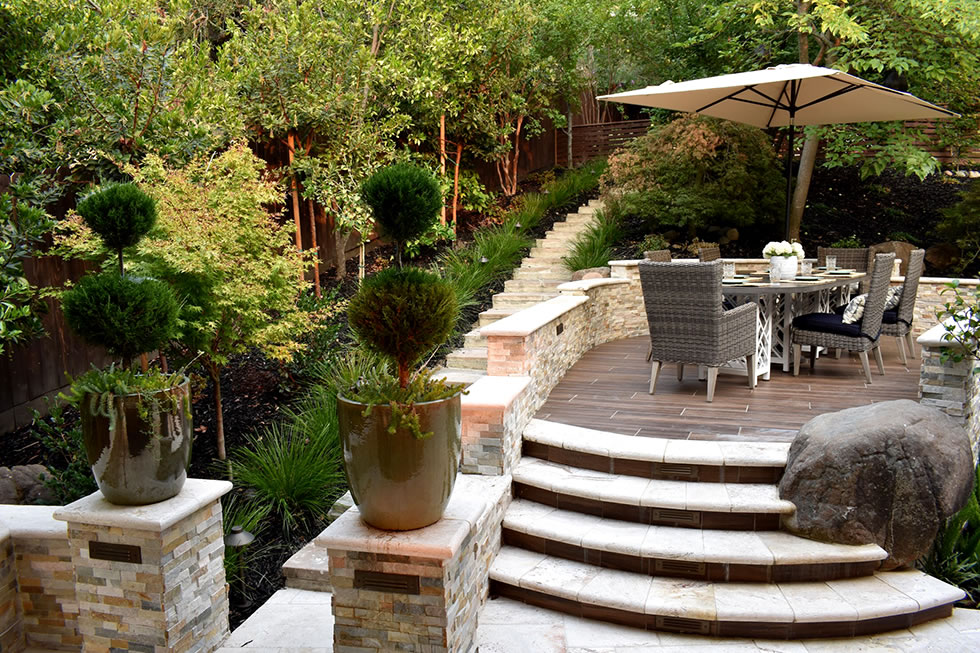
Outdoor living space has become one of many home owners’ top priorities. A healthy lawn, trees and seasonal plantings, as well as amenities such as a deck, swimming pool, pond, walkways and outdoor lighting, all help expand indoor square footage, improve the look of your yard for yourself, neighbors and community, and increase the value of your home exponentially.
Getting started can be tough, especially when you work with a blank canvas. Too many home owners fail to plan for how they want to use their property now and long-term, preferring instead to go to a nursery and buy a few of this flower or that shrub. Putting in perennial beds with cone flowers, astilbe, Russian sage and asters can be delightful until you realize that where you planted your flower garden was the best site for the pond you always envisioned. Which will go? Which will stay?
Therefore, Sacramento, CA-based landscape designer Michael Glassman, co-author of The Garden Bible: Designing your Perfect Outdoor Space (Images Publishing), always advises new clients to start with a master plan and budget. The plan becomes a road map they can follow over the course of a year or 10 years, whatever works! Under ideal circumstances, the budget should equal 10 percent to 30 percent of the value of your house, so set some money aside for your outdoor areas. "Many spend so much on their interior choices, then neglect doing so outside," Glassman says. In the best cases, the outdoor areas can be enjoyed from the inside – either looking out or opening the home to such areas as decks, patios or conservation areas.
Here are six tips to gain a garden that will grow through the years and enhance your lifestyle and your home.
#1. Hire an expert to save time. Expertise is readily available from the staff of your neighborhood garden shop to community college with extension service and local growers that may produce everything from seed. Do some research and take the time before you visit any, so you’ll get more bang for your buck. For example, check how much sun—and shade—different parts of your garden receive most days, so you’ll know where to install a shade garden. Check the soil pH by taking a sample to your local nursery or sending it off to an extension service to measure the alkalinity or acidity levels to know whether blueberries and lilacs each will thrive, or if the soil first needs to be amended. Ask about the healthfulness of your trees by calling in an arborist, who can advise when it’s time to trim branches and remove unhealthy specimens. YourHome1Source.com will continue to add advice here in coming weeks and months. Other websites can help you find local talent. Three helpful sites are the American Society of Consulting Arborists for a certified arborist, the American Society of Landscape Architects and the Association of Professional Landscape Designers.
#2. Decide how you want to use your garden. There are no rules about what to include or avoid and the choices are many. You can make your garden a showplace for the most beautiful, colorful annuals that bloom throughout the season and offer a host of fragrances, textures and heights. Or you can divide parts of your property – even if small – into "rooms" that serve different functions. How about a place to lounge, another to cook and eat with maybe a pergola overhead, yet another for activities–bocce ball, croquet or badminton, and maybe a therapy garden to meditate or do yoga? Take your time to decide but do so in advance of digging that first bed to avoid buying and installing and then ripping out materials. If your interests change and you decide you want fruit trees, so you can make special berry pies, revise your site by finding an area where they will grow. Flexibility is an essential tool.
#3. Think of your garden as a canvas but don’t cram in too many elements that compete. Find the right balance and enough texture for interest but not a confusing mix. The most beloved gardens incorporate different fragrances but not an overwhelming array, plus some height variations and color palettes (maybe, a rainbow but sometimes a more limited white and green mix). And because plantings are alive, few last all season. They bloom and fade, which is why it’s important to make selections that offer what’s called "seasonal bloom." That way there’s always something new appearing throughout the season until it’s time to put your garden to bed. If you pick carefully, certain trees will have leaves appear come spring, summer and fall and may still look lovely in winter because of berries that appear or the architecture of their branches when bare or with snow.
#4. Understand potential problems since gardens are alive. Gardens have been described as outdoor rooms—and they certainly can be. However, there’s also a big difference from indoor rooms in that the outdoor counterparts are filled with living, breathing elements, from the grass to the flowers and trees and the bugs and animals that inhabit them. Find out what creatures may visit and even devour your newly planted hostas, strawberries or kale. Once they do, you’ll quickly learn to pick choices that don’t appeal, as well as find healthy pesticides to discourage munching. The climate should also be considered. Hot weather and potential droughts call for research on what will grow in your area without daily watering. Often, it’s best to go with native choices. This is another reason it’s wise to have an expert in your contact list when the temperature is hot for days on end and you are eager for solutions to keep your plantings alive. The same holds true for areas of the country where there’s cold and snow.
#5. Determine how much maintenance you want to do. Few of us can afford to tackle all the work involved in making gardens come alive and look healthy, from the planting to pruning, mowing, watering, weeding, mulching, and so on. And then there’s all the work connected with keeping your hardscape of decks, walks and fences looking their best. Decide before you put up a wood picket fence if you’re prepared to repaint it every few years. You may want to go with a faux wood; same goes for a deck since there are many new composites available that require little or no work. And even Adirondack-style chairs are now made in polywoods® that last a long time without care. Most of these facsimile products will cost more initially but will last far longer without attention. Your goal most likely is to sit back and enjoy your garden.
#6. Don’t forget the extras. Gardens benefit from just the right finishing touches or even some bling. How much you want in your yard usually depends on your budget, the site—its topography, and style of the garden (Zen means much more spare than Victorian exuberance). If you want to use your garden at night or at least view it from inside your home looking out, you’ll want to install some LED lights and maybe a fire pit or fireplace. If you like the idea of pleasant sounds outdoors, you may want to include water that trickles and spills over rocks or a fountain, chimes that jingle when breezes blow, or an outdoor sound system since so many today are wireless and don’t need to be plugged in. To enjoy meals without the heat beating down on your head, consider an umbrella over a table or retractable awning. And, of course, bring out Citronella candles or some bug zappers to keep away mosquitoes and flies.
Parting lesson. Remember that having a great garden requires great patience. Glassman always teaches his clients and those wanting to gain a green thumb: The first-year gardens sleep, the second year they creep and the third year they leap! After that you’re on your own but be prepared for the boundless joy they will bring.
